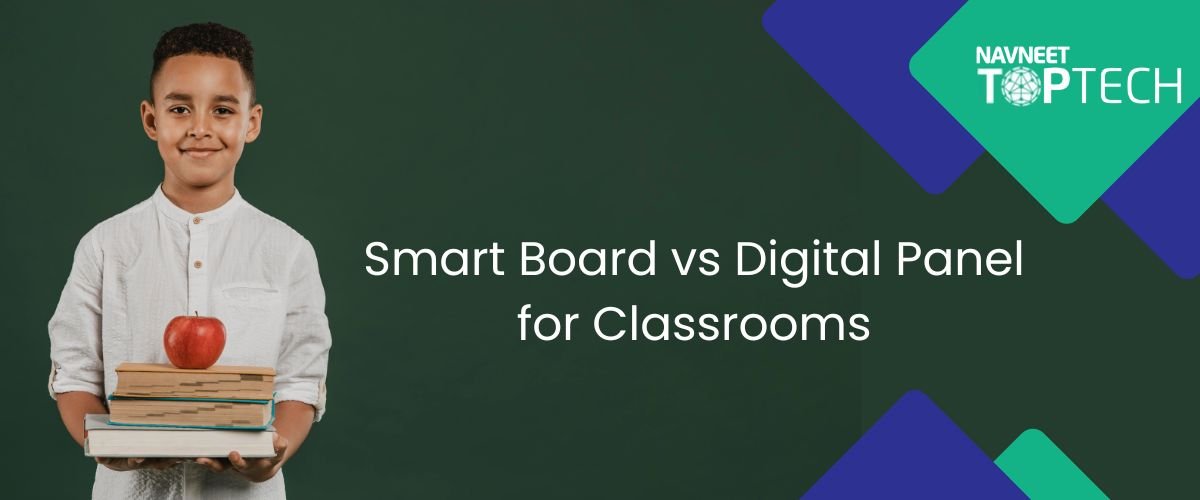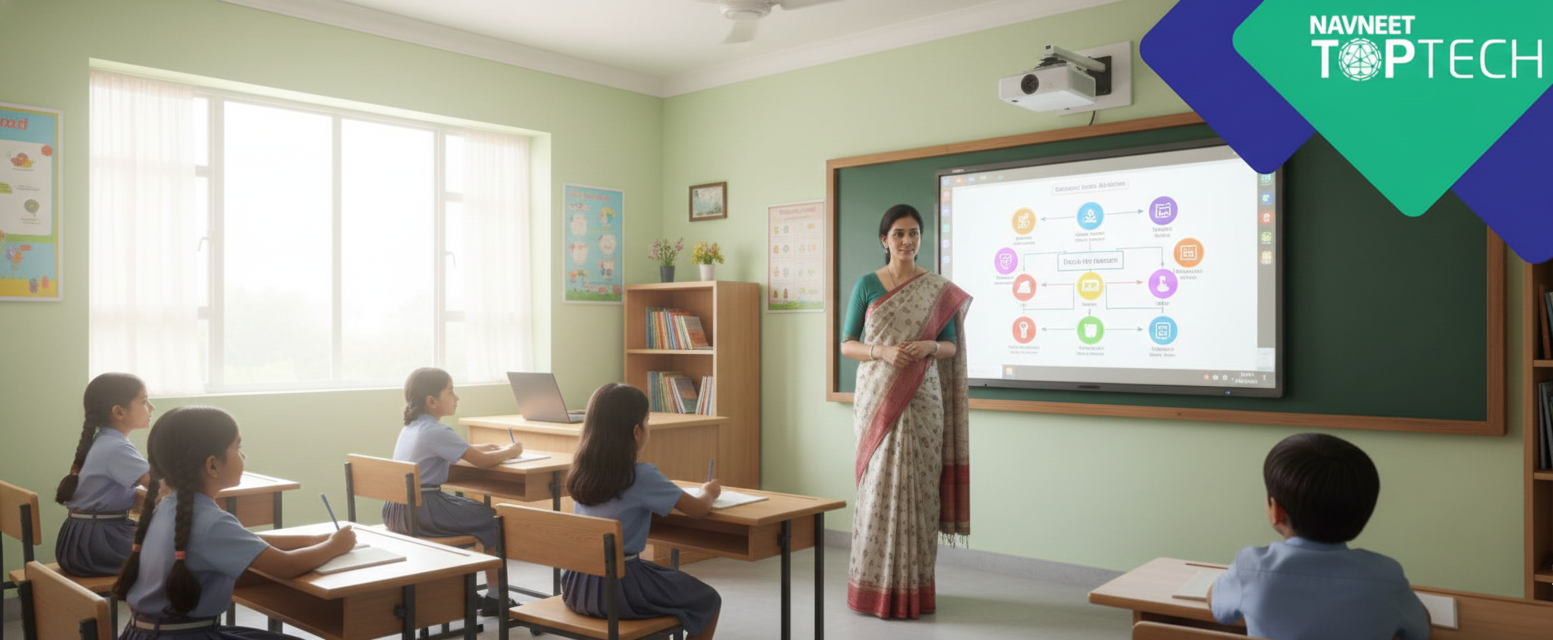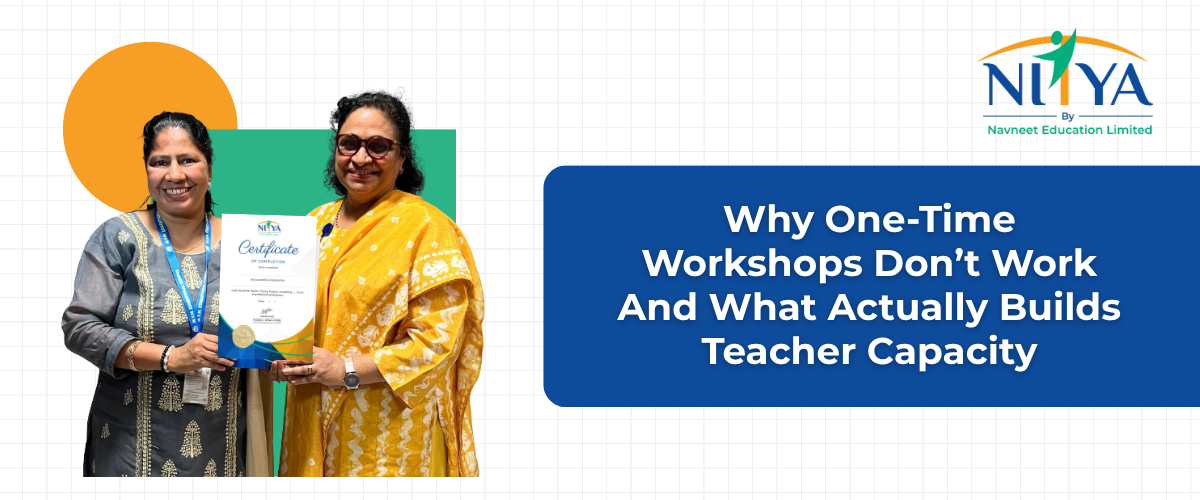What comes to mind when one hears the word ‘classroom’ in 2025? A blackboard, chalk, a teacher, and students sitting on wooden desks? Well, that’s not the case anymore, is it? Classrooms have gone digital, thanks to the advent of technology. The traditional methods of teaching are making way for smart boards for schools and digital panels for classrooms.
The primary catalysts behind this shift in teaching methods include:
- The growing need for interactive, multi-media-based teaching.
- Enhanced student engagement through visual methods and collaborative approaches.
- The worldwide push towards technology-integrated learning environments is in line with global trends and the NEP 2020.
In the introduction, we’ve talked about two commonly used tools for advanced learning, smart boards and digital panels. Both enhance learning, but the technology behind them, costs, and their benefits differ. And in this blog, we’ll look at both.
What is a Smart Board? Features, Benefits, and Limitations
A smart board for classroom use is essentially a large touch-sensitive surface connected to a computer and projector. It allows teachers to control presentations, annotate documents, and display videos directly on it.
How does it work for schools?
- At the core, it is based on a projector that displays the connected computer’s content onto the board.
- The said board is responsive to touch or stylus input.
- Notably, smart boards also allow teachers to save the annotated lessons for later reference.
Key Benefits of Smart Boards for Teachers
- Interactive Learning: Both students and teachers can write, draw, or manipulate the on-screen content.
- Budget-friendly: When it comes to upfront costs, smart boards cost much less than digital panels.
- Highly Compatible: Works perfectly well with commonly used software such as MS Office and web browsers.
Limitations of Smart Boards for Schools
- Not as much a limitation as it is an added responsibility, smart boards require projector maintenance (calibration, bulb changes, etc.).
- The image quality usually depends on the lighting and the brightness of the projector.
- The lifespan of smart boards is slightly shorter due to the projector’s wear and tear.
What is a Digital Panel for Classrooms? Features, Benefits, and Limitations
A digital panel for classrooms, also known as a digital whiteboard for teaching, is a huge touchscreen display that boasts a built-in operating system.
How does it work for schools?
- In the case of digital panels, no projector is needed, and the panel itself displays all the visuals.
- Digital panels can run apps directly, including both Windows-based and Android-based apps.
- Digital panels for schools also offer multi-touch for multiple users at once.
Key Benefits of a Digital Board for Teaching
- Better Display Quality: Irrespective of the lighting in the classroom, digital panels offer bright and high-resolution images.
- Low Maintenance: Digital panels need no calibration, have no bulbs, and have fewer parts to replace overall.
- All-in-one functionality: Digital panels come with wi-fi, educational software, speakers, and a built-in operating system.
Limitations of Digital Panels for Schools
- Involves a higher upfront investment as compared to smart boards.
- The equipment is heavier and requires professionals for a seamless installation.
- Teachers at the school might need some extra training to adapt to this technology.
Smart Board vs Digital Panel: Key Differences at a Glance
Here’s a quick comparison of smart board vs digital board features:

Smart Board or Digital Panel: Which Is the Better Investment?
Choosing the right tool depends on budget, teaching style, and your school’s long-term plans.
When to Choose a Smart Board for Classroom Use:
- If your school already has projectors and is willing to upgrade affordably.
- If your teachers prefer PC-based workflows and familiar software.
- If the classroom lighting is dimmable to make way for better projector visibility.
When to use a Digital Panel for Classroom Use:
- If you want top-tier display quality for videos, images, and simulations.
- If your school wants low maintenance and long-term reliability.
- If your school is aiming for a completely integrated and modern classroom environment.
Schools are also opting for a blended approach:
Several schools are skipping the choice between these two and opting for a mixed approach.
Here’s how:
- Smart board for schools in general classrooms, as it is a cost-effective measure.
- Digital panels for classrooms in labs, media centers, and highly interactive classes and subjects.
Importance of Teaching Style Considerations
- For teacher-led and presentation-heavy lessons, smart boards are sufficient as they offer the necessary interaction without overhauling the existing teaching habits of educators.
- For collaborative and student-driven projects, digital panels are a better option as they allow multiple users and swift switching between different tools.
- For STEM or creative objects, the clarity and precision of a digital board for teaching is especially beneficial.
What Should Your School Choose?
In 2025, the smart board vs digital board is not a technological debate anymore; it has become a necessary strategic decision that schools must take.
Smart boards remain a cost-effective, familiar, and functional option for traditional teaching styles.
Digital panels, on the other hand, deliver cutting-edge visuals, durability, and modern learning experiences that are ideal for future-driven schools.
Our TopClass Digital Classroom Solutions are designed specifically for Indian schools and boards. Unlike purely online tools, TopClass works completely offline, ensuring uninterrupted teaching even in areas with limited internet access.
It integrates interactive smart boards with comprehensive digital content, giving teachers the confidence to deliver lessons without worrying about connectivity issues.
Key Features:
- Offline functionality – no dependency on the internet for daily teaching
- Digital assignment sharing to simplify teacher–student communication
- Media-rich lessons for deeper student engagement
- Interactive tools that make learning participative and impactful
Choosing between a smart board for teaching and a digital panel for classrooms doesn’t have to be a binary decision.
Evaluate your infrastructure, teaching objectives, and long-term tech strategy. Here’s a clearer picture to help you make the decision:
- Smart boards are ideal for familiar, cost-conscious setups.
- Digital panels deliver superior visuals and low maintenance for forward-thinking schools.
NAVNEET TOPTECH offers versatile solutions that combine smart board hardware with platform-level teaching tools, making them a valuable option for hybrid approaches.




